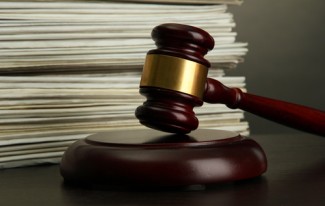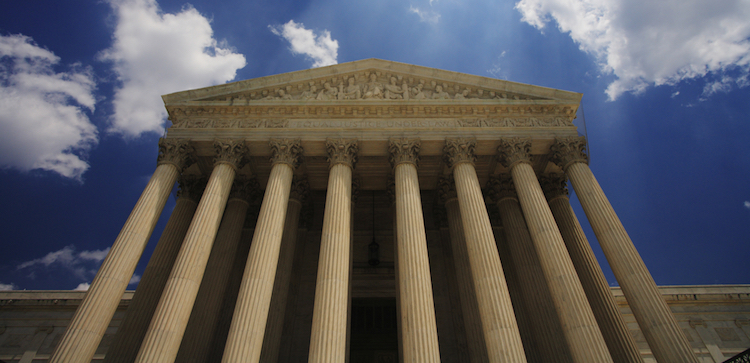When the Supreme Court cites your amicus brief

Image from Shutterstock.
When the U.S. Supreme Court releases a decision, the parties and their lawyers scan the opinions to determine whether they won or lost. Meanwhile, those who filed amicus curiae, or friend of the court, briefs in the case also want to know the outcome. But first, they are eager to find the answer to a different question: Did one of the justices cite my brief?
“Your worst fear as an amicus brief writer is that no one reads the brief,” says Lisa E. Soronen, the executive director of the State and Local Legal Center in Washington, D.C., which organizes and files briefs in a range of cases of interest to government agencies, often in conjunction with groups such as the National Association of Counties or the U.S. Conference of Mayors.
Soronen says that during her 10 years on the job, the justices have cited one of her group’s briefs at least once in every term but one. In 2017, things were looking dim for a citation until the last few days of the term, when Justice Anthony M. Kennedy cited her brief in his majority opinion in a case about a local government’s taking of private property.
“A citation shows they read the brief,” Soronen says, “and it makes it so much easier to say that we made a difference.”
Views to offer even with ‘no dog in the fight’
Scholars in recent years have documented a marked increase in the number of amicus briefs filed in Supreme Court cases. Only a handful of fully briefed and argued cases each term have no amicus filings, and the biggest cases attract dozens if not scores of briefs by outside groups.
“There has been an explosion of amicus briefs,” says Anthony J. Franze, a member of Arnold & Porter’s appellate and Supreme Court practice. Franze and his colleague R. Reeves Anderson have been compiling data on amicus practices at the high court for more than a decade.
In a recent 10-year period, the average number of amicus briefs filed increased from nine per argued case in the 2010-11 term to 16 per argued case in the 2019-20 term, Franze and Anderson said in a November 2020 report.
There has also been a marked increase in citations to those briefs by the justices, their figures show.
In cases with signed opinions that included the filing of at least one amicus brief, the justices cited amicus briefs in a little more than half of cases each term over the recent decade studied, Franze and Anderson said. In the 2019-20 term, the figure was 65 percent, well above that average and the highest over the previous decade, the lawyers report. (They are still crunching the numbers for the 2020-21 term.)
“There is more content for the justices to review and for their law clerks to alert them to,” says Franze. “So naturally, you are going to see a higher citation rate.”
Although not every citation by a justice to a particular amicus brief is positive, Supreme Court advocates and groups who are “frequent filers” tend to celebrate their citations.
“We’re always happy when our brief can provide some useful information or ideas to the justices,” says Mark L. Rienzi, the president of the Becket Fund for Religious Liberty in Washington.
“When we’re filing an amicus, it means we don’t have a dog in the fight” in terms of representing the parties, Rienzi adds, but “we’re offering our area of expertise, which is the First Amendment and religious liberty.”
In July, Justice Clarence Thomas cited the Becket Fund’s brief in his concurrence in Americans for Prosperity Foundation v. Bonta, in which the court invalidated a California disclosure requirement for certain donors to charitable organizations.
Equally gratifying to the group was that its brief was mentioned several times during oral arguments in the case in April. Two justices cited the brief, which argued that the First Amendment right to assembly, including religious assembly, includes the right of people to associate anonymously.
“We were happy with that, too,” says Rienzi.
 Image from Shutterstock.
Image from Shutterstock.
Informing a line of questioning
In the 2019-20 term, Justice Samuel A. Alito Jr. cited the Becket Fund’s amicus brief in his concurrence in Espinoza v. Montana Department of Revenue, in which the court held that the application of a state constitutional provision to bar state aid to religious schools violated the First Amendment rights of parents seeking to benefit from a state tax credit.
Alito cited Becket, along with about 18 other amicus briefs in the case, for their discussion of what those briefs, and he, characterized as the anti-Catholic origins of the Montana constitutional provision barring aid to religious schools. (The opinion’s sheer number of citations to separate amicus briefs on a single point may have set some form of record.)
Brianne J. Gorod, the chief counsel of the Constitutional Accountability Center, a progressive think tank and legal organization in Washington that often files amicus briefs, says her group took satisfaction during the last term when its brief in a criminal case was cited both at oral argument and in the court’s opinion.
In Lange v. California, the court ruled that under the Fourth Amendment, police pursuit of a fleeing misdemeanor suspect does not categorically justify officers entering a home without a warrant. The CAC’s brief was cited by Justice Neil M. Gorsuch at oral argument and by Justice Elena Kagan in her majority opinion siding with the defendant.
“In Lange, we used our amicus brief to dive deep into the common law and point out that the common law prohibited officers from pursuing suspects into homes,” Gorod says. “We thought that was the relevant history here and we were very gratified to see the court agree.”
Professors for better amicus briefs
Supreme Court advocates and others have long viewed amicus briefs as being of varying value to the deliberative process. Some justices assert—publicly, at least—that while they read the main briefs filed by the parties, they are content to let their law clerks digest amicus briefs.
Many amicus briefs are considered of the “me, too” variety—some groups filing in the biggest cases just to be able to say they had done so, even when they don’t have much original information to offer.
But other briefs are considered more valuable, such as those from the U.S. solicitor general’s office and state and local governments, briefs on behalf of law professors or scholars in a particular field, and briefs from advocacy groups with long-standing reputations for filing useful briefs.
Anderson and Franze note that in the 2019-20 term, every member of the court cited a brief by professors in at least one of their opinions. That includes Thomas, who has jokingly, and derisively, referred to such briefs as being filed by ad hoc groups such as “Law Professors for a Better World.” (Still, Thomas cited a brief filed by law professors in his dissent in a 2020 securities law decision.)
Allison Orr Larsen, a professor at William & Mary Law School in Williamsburg, Virginia, has studied amicus briefs for years and focused much of her critique on those that present so-called legislative facts—information outside the record of the case related to the legislative or policymaking function of a court.
In a 2014 study, Larsen found that one of every five amicus citations by the justices was used to support a factual assertion, while a more recent review she conducted suggested that half of all the citations related to legislative facts. She is troubled by the justices’ reliance on such materials from outside the adversarially tested record of a case.
“I look at citations because that is the only real evidence we have of amicus briefs’ influence,” says Larson, who read her share of briefs as a law clerk to Justice David H. Souter. “It is the best way we have to measure whether the justices are being influenced by the briefs at all.”
Larsen says she doesn’t argue that the justices “shouldn’t be well-read or should put their heads in the sand. But I worry that without any procedure or regulation, they are going to be drawn to the same sources over and over again without stress-testing the information.”
Larsen has testified about amicus briefs, and the justices’ citations of them, before Congress and the Biden administration’s Presidential Commission on the Supreme Court of the United States, where she has called for greater transparency and increased disclosure rules.
Anderson, the Arnold & Porter lawyer who studies briefs with his colleague Franze, says any reform in this area would likely have to come from Congress. The justices have maintained relatively hospitable rules for the filing of amicus briefs even in the face of documented criticisms, he notes.
“It doesn’t appear the court has perceived this as a problem,” Anderson says.



